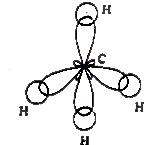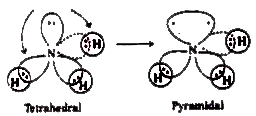Explain the formation of BF3 molecule with the help of Valency Bond theory.Solution in Telugu
The valence bond theory explains the shape, the formation and directional properties of bonds in poly atomic molecules like BeCl2,BCl3,CH4,NH3,H2O, etc. in terms of overlap and hybridisation of atomic orbitals.
E.g., in BeCl2, Be is the central atom. Its atomic number is 4. Therefore its ground state electron configuration is 1s22s2. In order to explain the formation of BeCl2, SP hybridisation is to be assumed for Be in its excited state. The excited state configuration of Be is 1s22s12p1x2p0y2p0z. As a result of which two sp hybrid orbitals will form on it. Now the two sp hybrid orbirtals overlap Head-Head with 3pz orbitals of two chlorine atoms forming two sigma bonds.
The molecule is linear and the bond angle is 180∘.

In BCl3 the central atom is boron. Its atomic number is 5. Therefore its ground state electron configuration is 1s22s22p1x2p0y2p0z. Form this configuration it is evident that it exhibits mono-valency. The first excited state configuration of B is 1s22s12p1x2p0y2p0z. Since, there are two half-filled orbitals, the valency of Boron is 3.
In order to explain the formation of BCl3 molecule sp2 hybridisation is to be assumed to boron atom in its excited state I. As a result of which three sp2 hybrid orbitals will form on it. Now, the three sp2 hybrid orbitals of 'B' atom overlap Head - Head with 3pz orbitals of three Cl atoms forming three sigma bonds. 'The shape of the molecule is plane triangular is plane triangluar and the bond angle is 120∘.

CH4 (Methane) : In CH4 the central atom is carbon. Its atomic number is 6. Therefore the electron configuration is 1s22s22p2(2p1x,2p1y,2p∘z). In order to explain the formation of four bonds excited state configuration (1s22s12p1x2p1y2p1z) is to be taken. From this configuration, we can say that carbon can form four bonds. [Ex.CH4]

In the formation of methane molecule the central carbon atom undergoes sp3 hybridisation in its excited state (1s22s12p1x2p1y2p1z). As a result of which four sp3 hybrid orbitals form on it. Each of them contains an unpaired electron. Now, these four hybrid orbitals overlap Head-Head with 1s orbitals of four hydrogen atoms forming CH4 molecule. The strucrture of the molecule is tetrahedral. The bond angle is 109∘28'. Since there are no lone pairs, there is no distortion in the structure of the molecule.
NH3 (Ammonia) in NH3 molecule, one sp3 orbital contains a lone pair of electrons. There will be repulsions between the lone pair and bond pair electrons. These are stronger than bp - bp repulsions. (l.p−b.p>b.p−b.p). So the bond pairs are pushed together. Hence the bond angle decreases from tetrahedral angle. The molecule assumes a pyramidal shape.

Topper's Solved these Questions
- BOOK - VGS PUBLICATION-BRILLIANTCHAPTER - CHEMICAL BONDING AND MOLECULAR STRUCTUREEXERCISE - SHORT ANSWER QUESTIONS33videos
CHEMICAL BONDING AND MOLECULAR STRUCTURE
- BOOK - VGS PUBLICATION-BRILLIANTCHAPTER - ATOMIC STRUCTUREEXERCISE - ADDITIONAL QUESTIONS & ANSWERS22videos
ATOMIC STRUCTURE
- BOOK - VGS PUBLICATION-BRILLIANTCHAPTER - CHEMICAL EQUILIBRIUM AND ACIDS-BASESEXERCISE - ADDITIONAL QUESTIONS & ANSWERS8videos
CHEMICAL EQUILIBRIUM AND ACIDS-BASES
Similar Questions
Write the general properties of Ionic Compounds.
01:57View SolutionCalculate the number of protons , neutrons and electrons in .8035Br
06:30View SolutionPCl5,PCl3 and Cl2 are at equilibrium at 500K and having concentration 1.59MPCl3,1.59MCL2 and 1.41MPCl5. Calculate Kc for the reaction PCl5⇔PCl3+Cl2
01:07View Solutionसंयोजकता आबन्ध सिद्धान्त के आधार पर H2 अणु के विरचन (निर्माण) कि व्याख्या कीजिए ।
03:49View SolutionDiscuss the formation of [FeF_(6)]^(3-) with the help of valence bond theory.
00:59View SolutionExplain the formation H2 molecule on the basis of Valence Bond theory.
01:57View SolutionExplain the bond formation of hydrogen molecule.
View SolutionIn valence bond theory H_2 Explain the formation of an atom /
55:41View Solutionవేలన్సీ బంధ సిద్ధాంతం ద్వారా BF3 అణువు ఏర్పడు విధానాన్ని వివరించండి.
04:44View SolutionExplain the formation of H2 molecule on the basis of valence bond Theory.
02:06View SolutionFormation OF Molecules on the Basis OF Valence Bond Theory (VBT)
10:17View SolutionDescribe the formation of HF and NH3 molecules on the basis of valence bond theory.
02:21View SolutionDescribe the formation of H2O molecule on the basis of valence bond theory.
04:50View SolutionDescribe the salient features of valence bond theory. Explain the formation of H2 molecule on the basis of this theory.
03:00View SolutionElectronic theory of valencies' is appreciable because, _____
i) it explains formation of an ionic bond
ii) it explains formation of a covalent bond.05:06View SolutionExplain the formation of the following molecules using valence bond theory. N_2 molecule
04:39View Solution

